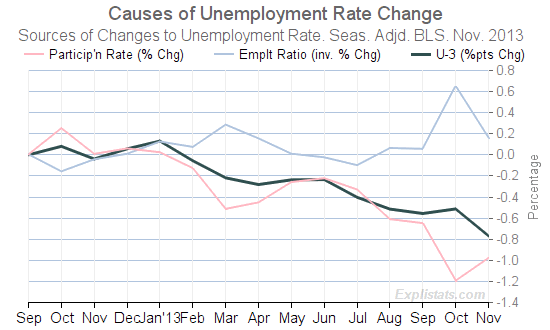
Click to enlarge
U3 Rate
The unemployment rate dropped by 0.03% points in November, following the gyrations of the government shutdown.
However, disappointingly, the trend down in unemployment continues to be fueled by a reduction in the labor force participation rate: Fewer people are looking for a job.
For more charts and tables at finer levels of detail, please visit our Household Survey Dataset Page.
Participation Rate and Employment Ratio
In the chart below we show the two factors contributing to the change in the unemployment rate.
 The employment/poulation ratio is shown inverted in this chart. The employment ratio tells us what percentage of the working-age population have a job. If more people who want a job, have one, then the line in the chart drops.
The employment/poulation ratio is shown inverted in this chart. The employment ratio tells us what percentage of the working-age population have a job. If more people who want a job, have one, then the line in the chart drops.
See how the employment ratio has worsened since July? The blip up in October was caused by furloughed government workers, and has dropped out of the equation by November.
But this has been masked by an accelerating drop in the Labor Force Participation Rate: This tells us what percentage of people of working age, wish to work (are looking for a job). This again was distorted by October furloughs, but overall it has dropped since July – and more than the Employment Ratio.
The Participation Rate fall has won out, resulting in a dropping Unemployment Rate.
For the total population, and for the key age group of 25 years and over, the November Participation Rate in November is lower than it was in September, than in July and than last November.
Similarly, for those groups, the Employment Ratio has also dropped over those time frames
For example: In November 2012, the Employment Ration for 25 year-olds and older was 61.0%. It is now 60.7%.
Meanwhile the Participation rate for this group also fell, but by a larger margin: From 65.2% to 64.5%.
Caveat: The BLS does not publish the effect on past seasonally adjusted monthly numbers. The recent shutdown gyrations may have led to recent adjustments coming with (unpublished) adjustments to past months. We are thus not comparing apples with oranges. Next month, the BLS will reveal all past adjustments and we will get the true picture.
